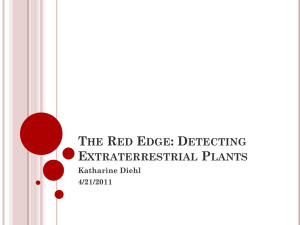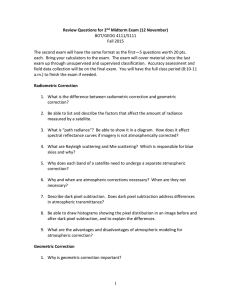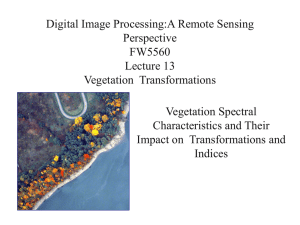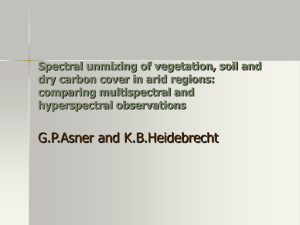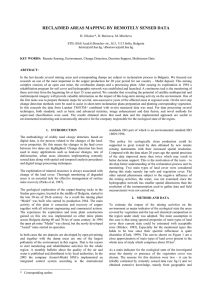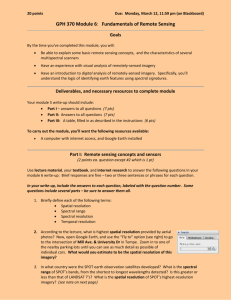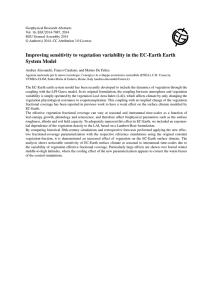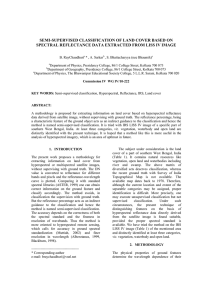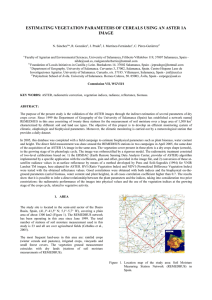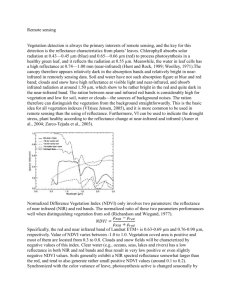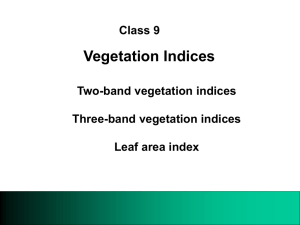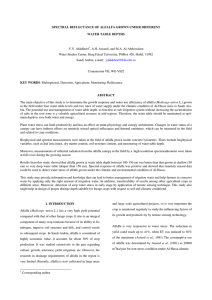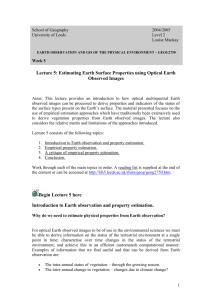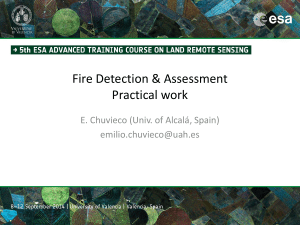Lecture 7: Natural Surface Radiative Properties
advertisement
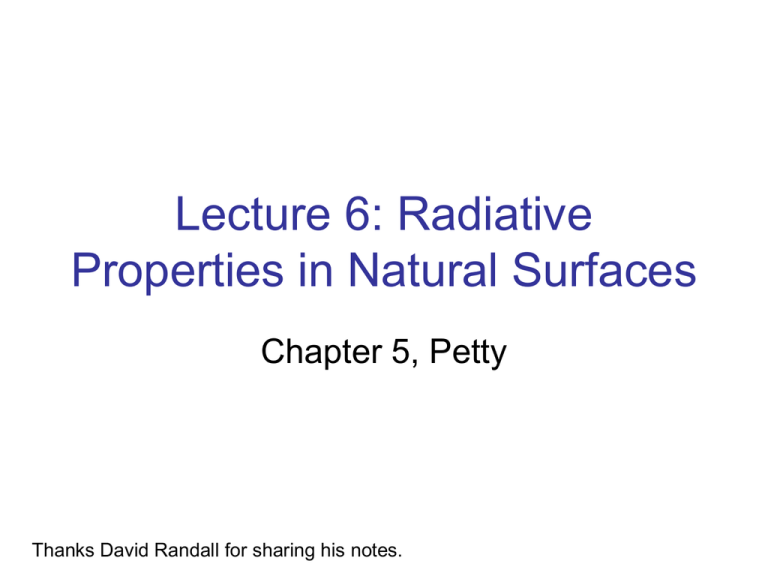
Lecture 6: Radiative Properties in Natural Surfaces Chapter 5, Petty Thanks David Randall for sharing his notes. Surface Reflectance and Ocean Temperature http://visibleearth.nasa.gov/view_rec.php?id=2366 • MODIS's 36 spectral bands provide scientists the chance to study many of Earth's terrestrial and oceanic characteristics with a single instrument, for example, Sea Surface Temperature (SST) and Land Surface Reflectance (LSR). This image was made from data collected during the month of May 2001. The LSR portion of the image is made from data collected at three wavelengths: 645 nm (red), 555 nm (green), and 469 nm (blue). This combination is similar to what our eyes would see. Combined with the land surface data are MODIS's measurements of SST in May, using detectors that capture thermal radiation at 4.0 µm, a design innovation that improves measurements in moist areas, such as the tropics, where persistent clouds often interfere with satellite measurements of SST. Largescale temperature patterns are apparent, such as the Gulf Stream off the east coast of the United States, and the Kuroshio Circulation southeast of Japan Land Cover (www.bu.edu) Table 5.1: Shortwave (solar) reflectivity (in percent) of various surfaces. Fresh, dry snow Old, melting snow Sand, desert Dry vegetation Deciduous Forest Grass Ocean surface (low sun) Bare soil Coniferous Forest Ocean surface (high sun) 70–90 35–65 25–40 20–30 15–25 15–25 10–70 10–25 10–15 <10 • Absorptivity (a, unitless): Fraction of incident radiation that is absorbed. • Reflectivity (r, unitless): Fraction of incident radiation that is reflected. Since these depend on wavelength, refer to them as aλ and rλ. Since they depend on angle of incident radiation, write them as fn(θ,Φ). For opaque surface (no transmission): aλ(θ,Φ) + rλ(θ,Φ) = 1 [petty 5.1] • If the reflection is isotropic (independent of θ and Φ) then the reflected monochromatic (spectral) irradiance can be written as: Fλ,r = rλ Fλ,o [W m-2 nm-1] (Fλ,o = incident, Fλ,r = reflected) [petty 5.2] And the absorbed irradiance is: Fλ,a = Fλ,o - Fλ,r = Fλ,o - rλ Fλ,o = (1 – rλ) Fλ,o = aλ Fλ,o [W m-2 nm-1] [petty 5.3] Petty Figure 5.2. Shortwave reflectance spectra of various natural surface types. Where, in the visible, does chlorophyll absorb? Vegetation spectral reflectance Show a typical vegetation spectra – Also show the spectral bands of TM in the VNIR and SWIR as well as some of the basic physical process in each part of the spectrum Spectral signature The key will be that different materials have different spectral reflectances As an example, consider the spectral reflectance curves of three different materials shown in the graph In the solar reflective part of the spectrum (350-2500 nm), the shape of the spectral reflectance of a material of interest drives the band selection Recall the spectral reflectance of vegetation Select bands based on an absorbing or reflecting feature in the material In the TIR it will be the emissivity that is studied Spectral signature - Vegetation Samples shown here are for a variety of vegetation types All samples are of the leaves only That is, no effects due to the branches and stems is included NDVI –vegetation index A common method of monitoring surface vegetation is through the Normalized Difference Vegetation Index: This has long been used to monitor the vegetation, and changes in vegetation of the entire earth. NDVI for vegetation generally range from 0.3 to 0.8, with the larger values representing 'greener' surfaces. Bare soils range from about 0.2 - 0.3. Here is an example of NDVI over Europe, derived by German Remote Sensing Data Center. Graybody Approximation What is the Lambertian Reflectivity? The BiDirectional Reflection Function, BDRF – or BRDF Global Albedo ASTER: Death Valley NASA http://visibleearth.nasa.gov/view_rec.php?id=1514 • Since different materials reflect and emit energy in different ways, the Advanced Spaceborne Thermal Emission and Reflection Radiometer (ASTER), with its multi-spectral infrared channels, can provide detailed information about the composition of Earth’s surface. In this 3-D perspective view looking north over Death Valley, California, ASTER’s bands 13 (10.6µm), 12 (9.1µm), and 10 (8.3µm) are displayed in red, green and blue respectively. The data have been computer enhanced to exaggerate the color variations that highlight differences in types of surface materials. • Salt deposits on the floor of Death Valley appear in shades of yellow, green, purple, and pink, indicating the presence of carbonate, sulfate, and chloride minerals. The Panamint Mountains to the west and the Black Mountains to the east are made up of sedimentary limestones, sandstones, shales and metamorphic rocks. The bright red areas are dominated by the mineral quartz, found in sandstones; green areas are limestones. In the lower center of the image is Badwater, the lowest point in North America Definition: Skin temperature is the radiometric temperature retrieved from thermal emission via certain wavelengths Upward longwave radiation εσTskin4 Temperature Tskin Surface Atmosphere Window (8-12 µm) 3.1 Results: Global Scale (Jin and Dickinson 2010) (1-α)Sd +LWd-εσTskin4 -H-LE - G= 0 Rn The skin temperature used in calculating heat fluxes and radiation: G = f( Tskin- Tsoil) H = CDHU(Taero-Ta) LE =CDEU(qTskin*-qa) Eq. Eq. Eq. Snow Index - NDSI • To detect the presence of snow, recent satellite instruments include observations at 0.66 and 1.6mm. The atmosphere is transparent at both these wavelengths, while snow is very reflective at 0.66 mm and not reflective at 1.6mm . The Normalized Difference Snow Index: Why do we define NDSI this way? Red regions are snow covered, white regions are cloudy. Online Satellite Data Analysis • http://gdata1.sci.gsfc.nasa.gov/daacbin/G3/gui.cgi?instance_id=neespi • Plot land skin temperature for July 2008, USA using MODIS Terra data • Plot aerosol optical depth at 550nm for July 2008, USA, Terra MODIS • Plot H20 for July 2000 to July 2008, USA Terra • NDVI for July 2000-July 2008, 20-40N, 0-360 • Correlation between land skin temperature and NDVI from July 2000 – January 2010 For USA
